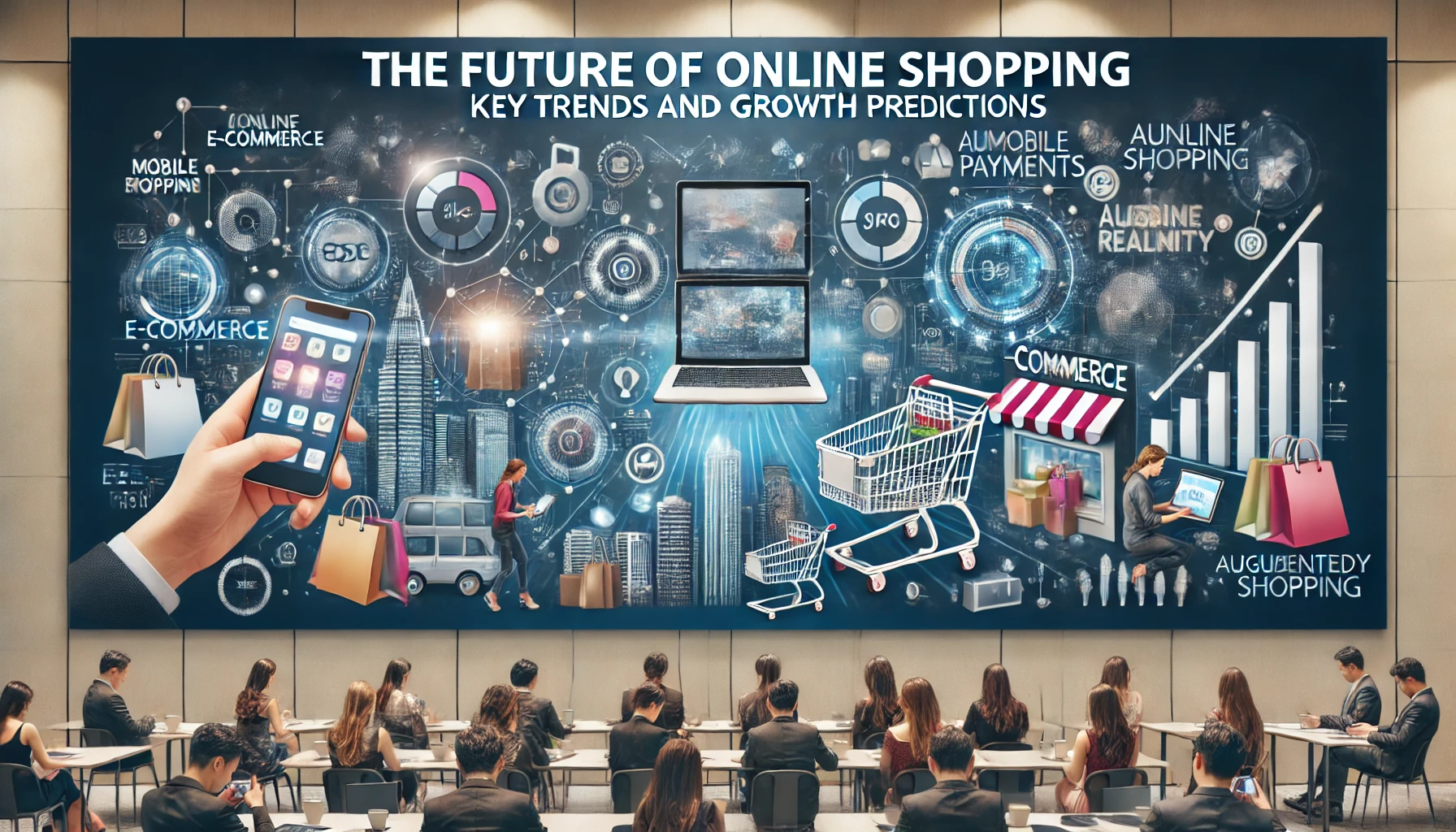The Future of Online Shopping: Key Trends and Growth Predictions
Online shopping has revolutionized the retail landscape, offering consumers unparalleled convenience and a vast array of choices. As we look to the future, understanding the key trends and growth predictions in online shopping is crucial for both businesses and consumers. This comprehensive guide will delve into the latest online shopping trends, e-commerce developments, and future predictions for the industry. We will also explore how these trends are shaping the future of online shopping and driving growth.
General Online Shopping Trends
Online Shopping Trends: A Comprehensive Overview
Online shopping trends are continually evolving as technology advances and consumer preferences shift. Here are some key trends that are shaping the online shopping landscape:
- Personalization and Customization: Online retailers are increasingly using data analytics to offer personalized shopping experiences. This includes personalized product recommendations, customized marketing messages, and tailored promotions based on individual consumer behavior.
- Subscription Services: Subscription-based models, such as monthly boxes and replenishment services, are becoming more popular. These services offer convenience and curated experiences that appeal to a wide range of consumers.
- Voice Commerce: With the rise of smart speakers and voice assistants like Amazon’s Alexa and Google Assistant, voice commerce is gaining traction. Consumers are using voice commands to search for products, make purchases, and track orders.
E-Commerce Trends: Driving Innovation
E-commerce trends are driving innovation in the online retail space. Here are some notable trends:
- Omni-Channel Retailing: Retailers are integrating their online and offline channels to provide a seamless shopping experience. This includes offering in-store pickup for online orders, integrating loyalty programs, and providing consistent customer service across all touchpoints.
- Augmented Reality (AR): AR technology is enhancing the online shopping experience by allowing consumers to visualize products in their own environment. For example, furniture retailers use AR apps to show how a piece of furniture would look in a customer’s home.
- Artificial Intelligence (AI): AI is being used to improve customer service through chatbots, optimize inventory management, and enhance product recommendations. AI-driven insights help retailers understand consumer preferences and optimize their operations.
Online Retail Trends: Adapting to Change
Online retail trends highlight the ways in which retailers are adapting to changes in consumer behavior and market dynamics:
- Sustainability: Consumers are increasingly prioritizing sustainability in their purchasing decisions. Retailers are responding by offering eco-friendly products, reducing packaging waste, and implementing sustainable supply chain practices.
- Fast and Free Shipping: Fast and free shipping options have become a standard expectation for consumers. Retailers are investing in logistics and supply chain efficiencies to meet these demands.
- Social Commerce: Social media platforms are becoming important channels for e-commerce. Features like shoppable posts and in-app purchasing are making it easier for consumers to buy products directly from their favorite social media apps.
Future of Online Shopping: Predictions and Insights
The future of online shopping is poised for significant growth and transformation. Here are some predictions and insights:
- Growth in Mobile Commerce: Mobile commerce, or m-commerce, is expected to continue its rapid growth. Consumers are increasingly using their smartphones for browsing, comparing prices, and making purchases.
- Expansion of Global E-Commerce: The global e-commerce market is expanding as more consumers gain access to the internet and online shopping. Emerging markets, in particular, present significant growth opportunities for online retailers.
- Integration of Blockchain Technology: Blockchain technology has the potential to enhance transparency and security in e-commerce transactions. It can be used to track the provenance of products, verify authenticity, and streamline payment processes.
Online Shopping Growth: Factors Driving Expansion
Several factors are driving the growth of online shopping:
- Convenience: Online shopping offers unparalleled convenience, allowing consumers to shop from anywhere, at any time.
- Variety: Online retailers can offer a wider variety of products compared to physical stores, catering to diverse consumer preferences.
- Competitive Pricing: E-commerce platforms often offer competitive pricing and discounts, attracting price-sensitive consumers.
Online Shopping Data and Behavior
Online Shopping Statistics: Key Metrics
Understanding online shopping statistics is essential for analyzing consumer behavior and market trends. Here are some key metrics:
- Cart Abandonment Rate: The percentage of online shoppers who add items to their cart but do not complete the purchase. High cart abandonment rates indicate potential issues with the checkout process.
- Conversion Rate: The percentage of website visitors who make a purchase. A higher conversion rate indicates a more effective e-commerce platform.
- Average Order Value (AOV): The average amount spent by a customer per transaction. Increasing the AOV can boost overall revenue.
Online Shopping Habits: Consumer Preferences
Online shopping habits provide insights into consumer preferences and behavior. Here are some common habits:
- Research Before Purchase: Many consumers conduct extensive research before making a purchase, including reading reviews, comparing prices, and watching product videos.
- Mobile Shopping: A significant number of consumers prefer to shop on their mobile devices due to the convenience and accessibility it offers.
- Loyalty Programs: Loyalty programs and rewards incentivize repeat purchases and foster customer loyalty.
Online Shopping Market Share: Industry Insights
Online shopping market share varies across different sectors and regions. Here are some insights:
- Electronics and Apparel: Electronics and apparel are among the top categories for online shopping, accounting for a significant share of e-commerce sales.
- Grocery and Home Goods: The online grocery market is growing rapidly, driven by the convenience of home delivery and subscription services. Home goods and furniture are also seeing increased online sales.
- Regional Differences: Market share can vary by region, with some countries and regions experiencing faster growth in e-commerce adoption than others.
Online Shopping Behavior: Trends and Patterns
Understanding online shopping behavior helps retailers tailor their strategies to meet consumer needs. Here are some trends and patterns:
- Impulse Purchases: Online shoppers often make impulse purchases, driven by targeted ads, limited-time offers, and easy checkout processes.
- Personalization: Personalized shopping experiences, such as product recommendations based on browsing history, can enhance customer satisfaction and drive sales.
- Returns and Exchanges: Flexible return and exchange policies are important for building trust and confidence among online shoppers.
Mobile Shopping
Mobile Shopping Trends: The Rise of E-Commerce on Smartphones
Mobile shopping trends highlight the growing importance of smartphones in the e-commerce landscape. Here are some key trends:
- Mobile-Optimized Websites: Retailers are optimizing their websites for mobile devices to provide a seamless shopping experience. This includes responsive design, fast loading times, and easy navigation.
- Mobile Apps: Many retailers are developing mobile apps to offer a more personalized and convenient shopping experience. Mobile apps can provide exclusive deals, push notifications, and streamlined checkout processes.
- Mobile Payments: The adoption of mobile payment solutions, such as Apple Pay, Google Wallet, and Samsung Pay, is making it easier for consumers to make purchases on their smartphones.
Future of Mobile Shopping: Predictions and Insights
The future of mobile shopping is bright, with continued growth and innovation expected. Here are some predictions:
- Augmented Reality (AR): AR technology will enhance the mobile shopping experience by allowing consumers to visualize products in their own environment before making a purchase.
- Voice Search: Voice search is expected to play a larger role in mobile shopping, with consumers using voice commands to search for products and make purchases.
- Increased Security: Advances in mobile security, such as biometric authentication and encryption, will help protect consumer data and build trust in mobile shopping.
Mobile Shopping Growth: Factors Driving Expansion
Several factors are driving the growth of mobile shopping:
- Convenience: Mobile shopping allows consumers to shop on the go, making it convenient and accessible.
- Enhanced User Experience: Retailers are investing in mobile optimization and app development to provide a better user experience.
- Social Media Integration: Social media platforms are becoming important channels for mobile shopping, with features like shoppable posts and in-app purchasing.
Conclusion
Understanding online shopping trends is essential for navigating the ever-evolving e-commerce landscape. From e-commerce trends and online retail innovations to mobile shopping growth and consumer behavior, these trends are shaping the future of online shopping. By staying informed about these trends and leveraging data-driven insights, businesses can better meet consumer needs and drive growth.
For more information and resources on online shopping trends, visit Regent Studies. Embrace the future of online shopping and stay ahead of the curve with the latest trends and innovations.
In conclusion, online shopping trends such as e-commerce trends, online retail trends, and mobile shopping trends are driving significant changes in the retail landscape. By understanding online shopping statistics, consumer behavior, and market share, businesses can adapt their strategies to thrive in this dynamic environment. Explore the future of online shopping and discover the key trends and growth predictions that will shape the industry in the years to come. For additional insights, check out resources like Statista for comprehensive data and analysis. Happy shopping!




